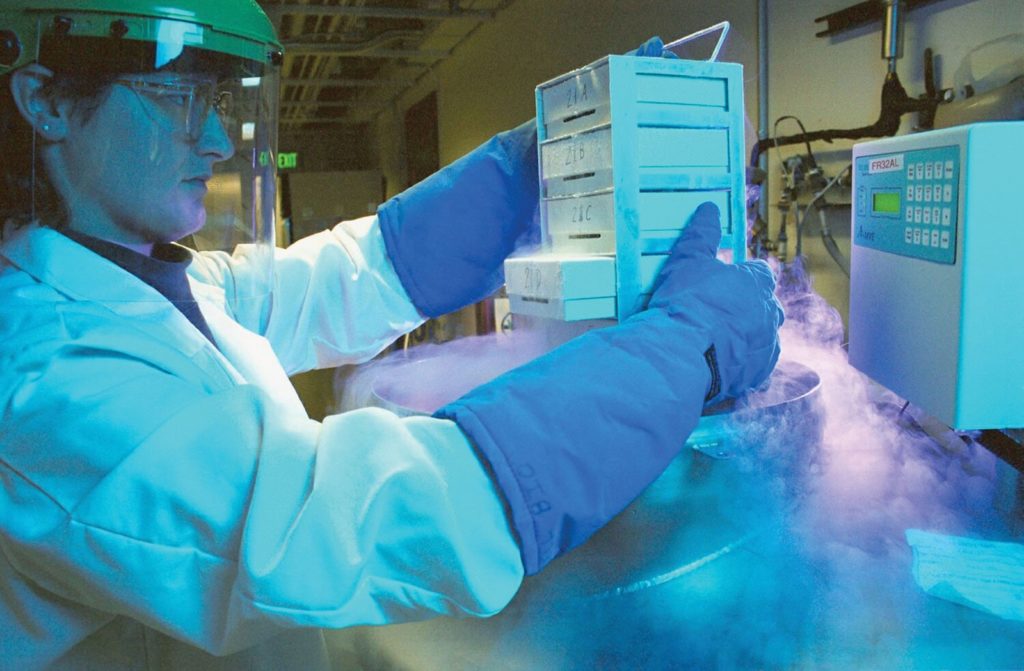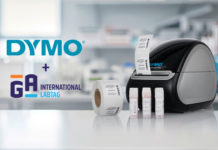
Over the last two decades, the biodiversity of our planet has dramatically decreased. This loss in the variety of life can have serious consequences, including the ecosystem’s functional breakdown. As such, it has become essential to preserve endangered species now, to ensure their survival for future generations. Conventional techniques did not prove to be sufficient, necessitating the use of cryopreservation. This process involves preserving cells, tissues, organs, or any biological material from expected damage by storing them at exceptionally low temperatures (- 80°C utilizing CO2 or −196°C using liquid nitrogen).
Cryopreservation primarily depends on the conversion of water present in the cells from a fluid to a solid-state. While the normal freezing point of water is 0°C, the water inside the cell needs a much lower temperature to freeze. This is due to the presence of inorganic molecules and salt, resulting in the metabolic cycles and biological activity within the cells/tissues becoming nearly halted when put away at low temperatures.
Why is it necessary to preserve cell lines?
Today, cryopreservation has a broad range of applications in the freezing of cell lines. Before we jump into how cryopreservation is done, let us first look at why we do it in the first place. Most cell lines grow quickly, and if not regularly sub-cultured, they will get over-crowded and die in the absence of sufficient air and nutrition. Likewise, cell cultures require constant checking on account of their high susceptibility to microbial contamination. Therefore, researchers cultivate a few clusters and save them for later when they need them.
The process of cryopreservation
Development of sterile tissue culture
When selecting plant species for preservation you should take into account their unique morphological and physiological characters and how they might influence the ability of the explants to endure cryopreservation. You can take any tissue from a plant to preserve it for cryopreservation, including endosperms, cultured plant cells, ovules, meristematic cells, meristems, embryos, protoplasts, calluses, or seeds. Usually, the most preferred ones are the suspension cell cultures, which are in the late lag phase or log phase.
Addition of cryoprotectants and pre-treatment
Cryoprotectants are the compounds that can forestall the harm caused to cells by freezing or thawing. Cryoprotectants lessen the freezing and super-cooling point of water. Thus, the process of formation of ice crystal gets delayed during cryopreservation. Using a combination of cryoprotectants is preferred for more viable cryopreservation without harming cells/tissues.
The most widely utilized cryoprotectants are dimethyl sulfoxide (DMSO), glycerol, ethylene, propylene, sucrose, mannose, glucose, proline, and acetamide.
Freezing
Cell sensitivity to low temperature generally depends on the plant species and is variable. The various kinds of freezing techniques utilized are the following:
- Slow-freezing technique: The tissue or the primary plant material is allowed to gradually freeze at a moderate cooling pace of 0.5-5°C/min from 0°C to – 100°C. At that point, it is moved to liquid nitrogen. The slow-freezing technique encourages the slow progression of water from the cell interior to the outside. This prevents intracellular freezing and advances extracellular ice crystal formation. Along these lines, the plant cells are dried out partially and can endure better. This method is effectively utilized for the cryopreservation of suspension cultures.
- Rapid freezing method: In this method, the vial carrying the plant material is placed in liquid nitrogen. There is a decrease in temperature from – 300° to – 1000°C/min during this process. The freezing cycle happens so rapidly that very small ice crystals take place inside the cells. Rapid freezing is applied for the cryopreservation of shoot tips and somatic embryos.
- Stepwise freezing method: This method is a mix of slow and rapid freezing methodologies having the upsides of both, and happens in a stepwise way. The plant material is first cooled to an intermediate temperature and kept for around 30 minutes. Next, it is rapidly cooled by putting it in liquid nitrogen. This strategy has been effectively applied for cryopreservation of shoot apices, buds, and suspension cultures.
- Freeze drying: This technique works on the principle of sublimation, i.e., converting a solid to gas, includes a freezing and a drying step. Freeze-drying is broadly utilized to save biomolecules and macromolecular particles and has been used to protect cells and tissues in the dry state.
Storage
Frozen cultures ought to be kept at a particular temperature. The frozen cells/tissues are usually stored at temperatures ranging from – 70 to – 196°C. At temperatures below – 130°C, ice crystals may occur inside the cells, diminishing cell viability. The preferred storage conditions are found at -150°C in liquid nitrogen in the vapor phase or at – 196°C in the liquid phase. It is essential to keep track of the viability of the germplasm consistently in individual samples. Appropriate documentation of the storage of germplasm is essential.
Thawing
Thawing or defrosting is generally done by plunging the frozen samples in vials into a water bath having a temperature between 37-45°C with vigorous swirling. Due to this process, thawing occurs rapidly at the pace, which protects the cells from the harmful impacts of ice crystal development. When thawing occurs, and the ice melts totally, the vials are moved to a water bath (20-25°C). Damage to the cells occurs when left in the water bath (37-45°C) for too long.
Re-culture
The thawed germplasm is washed thoroughly to remove any cryoprotectants. This material is subsequently re-cultured in a fresh medium by following standard procedures. In certain cases, the direct culture is used without washing as specific substances released by the cell at the time of freezing are thought to improve the in vitro cultures.
Viability measurement
The measurement of the frozen material’s viability and survival can be done at any phase of cryopreservation or in the wake of defrosting or re-culture. The methods that determine the viability of cryopreserved cells are the same as cell cultures. Commonly used methods include staining procedures with triphenyl tetrazolium chloride (TTC), Evan’s blue, and fluorescein diacetate (FDA).
Regeneration of plants
This step is the ultimate aim of the cryopreservation of germplasm. The cryopreserved cells/tissues must be nursed carefully and developed for proper plant growth and regeneration. Alongside the appropriate environment, the expansion of certain growth-enhancing substances is vital for effective plant recovery.

Advantages of Cryopreservation
- Minimum requirement of space and labor
- Fertility treatment
- Protection of genetic integrity of significant stains
- Protection of endangered germplasm species
- Protection of cell lines from genetic contamination
- Preservation of biological samples for an extended period
- Protection of cell lines from microbial contamination
- Prevention of genetic drift by cryopreservation of gametes, embryos, etc.
Cryopreservation has made some remarkable progress from being a dream in the mind of researchers to being a method for protecting valuable cell lines for medicinal and research purposes. Yet, there are many more milestones to achieve in finding new means to enhance revived cells’ cell viability after cryopreservation. Researchers are working on the expected utilization of various cryoprotectants with diminished toxicity to cells and new freezing strategies to guarantee cells’ expanded viability.
LabTAG by GA International is a leading manufacturer of high-performance specialty labels and a supplier of identification solutions used in research and medical labs as well as healthcare institutions.



